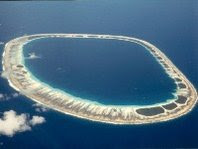Coral reefs are marine ridges or mounds, which have formed as a result of the deposition of calcium carbonate by living organisms, predominantly corals, but also a rich diversity of other organisms such as coralline algae and shellfish. Coral reefs provide a unique habitat characterised by high diversity and density of life. They occur globally in two distinct marine environments; deep, cold water (3-14°C) coral reefs, and shallow, warm water (21-30°C) coral reefs in tropical latitudes
Major coral reef sites are seen as red dots on this world map. Most of the reefs, with a few exceptions are found in tropical and semitropical waters, between 30° north and 30° south latitudes.
The condition of the growth of coral polyps.
1. High temperature- temperature above 20 degree Celsius.This is usually found in warm waters where the warm ocean current areas.
2. Clear shallow sea water- for the coral reef to survive well in seawater that is shallow and free from sediment. Coral need sunlight to grow , deep or muddy water is unsuitable.
3. Plentiful supply of oxygen and plankton- Coral need oxygen and plankton to grow. The part of the coast is washed by waves , currents and tides which maintain a fresh and plentiful supply of oxygen and plankton for the coral.
Types of coral reef
Fringing reefs
Reefs that are grow close to the coast. Most of the coral reefs in water of Singapore , Malaysia and Indonesia.
Barrier Reefs
Reefs that are situated further away from the coast in deeper water and are separated from the mainland by lagoons. The famous is Great Barrier Reef.
Atolls
are circular, oval, or horseshoe-shaped arrays of coral reef islands that are perched around an oceanic volcanic seamount and encircle a shallow central lagoon. The small islands are separated from each other by channels that lead from the sea into the central lagoon.
Distribution of Atolls
Because atoll formation requires coral reef building, atolls are limited to tropical waters. Atolls are most commonly found in the Pacific and Indian Oceans.
Size of Atolls
Atolls can vary greatly in size, ranging from quite small to over 130 kilometers (km) long and 32 km wide (Kwajalein in the Marshal Islands). The reef and lagoon area in some of the atolls of the Maldives are larger than 3000 km sq. Kiribati has a land area of about 390 km sq. Atoll islands are typically low lying, with elevations of less than 5 meters (m).
Atoll Development
Do you like this post? Please link back to this article by copying one of the codes below.
URL: HTML link code: BB (forum) link code:




